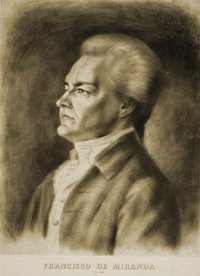Francisco de Miranda
|
|
Francisco de Miranda (March 28, 1750 – July 14, 1816) was a South American revolutionary whose own plan for the independence of the Spanish American colonies failed but who is regarded as a forerunner of Bolívar and other more effective American fighters for independence.
Born and raised in Caracas, Miranda was the son of a wealthy merchant from the Canary Islands, a province of Spain. He traveled throughout Europe, becoming a social sensation and garnering support for the independence of Spanish America. He had made friends with many important leaders and political figures throughout Europe, such as British Prime Minister William Pitt. Some claim that he even had an affair with Catherine the Great of Russia, although this is not only unconfirmed but also unlikely, due to the age difference.
Miranda took part in military operations in the three continents: Africa, Europe and America, and played an important role in some of the great historical events of the time. In the American Revolutionary War, he commanded Spanish troops aiding American insurgents in Florida and Mississippi. While in the U.S. he met with George Washington, Thomas Paine, Alexander Hamilton and Thomas Jefferson, among others. He had a home in London where he married a British lady and had two children.
Later, in the French Revolution, he served as an important French Revolutionary general. His name is engraved on the Arc de Triomphe in Paris.
His greatest contribution is probably in the independence struggle for the liberation of the colonies in Spanish America.
Miranda envisioned an independent empire consisting of all the territories which had been under Spanish and Portuguese rule, stretching from the Mississippi River to Cape Horn. The empire would be under the leadership of a hereditary emperor called "Inca" to appease the Native Americans and would have a bicameral legislature. He conceived the name "Colombia" for this empire, after the explorer Christopher Columbus.
Francisco_miranda_in_cadiz.jpg
With British help, Miranda made a failed invasion attempt of Venezuela at Coro in 1806. Among the volunteers who served under him in this revolt was David G. Burnet of the United States, who would later serve as interim president of the Republic of Texas after its secession from Mexico in 1836.
After Venezuela achieved de facto independence on April 19, 1810, Simón Bolívar persuaded Miranda to return to Venezuela, where he was made a general in the revolutionary army. When the country formally declared independence on July 5, 1811, he assumed dictatorial powers.
The Spanish forces counterattacked, and Miranda, fearing a brutal and hopeless defeat, signed an armistice with them in July 1812. Bolivar and other revolutionaries believed his surrender was treason and thwarted Miranda's attempt to escape; they handed him over to the Spanish Royal Army. He died in a prison in Cádiz, Spain, in 1816. An oil painting by the Venezuelan artist Arturo Michelena titled "Miranda en la Carraca" (1896) that portrays the hero in the Spanish jail where he died has become a graphic symbol of Venezuelan history and has immortalized the image of Miranda for generations of Venezuelans.
Daniel Florencio O'Leary, aide-de-camp to Simón Bolívar, said of Miranda's death: "Miranda was a man of the eighteenth century whose genius lay in raising the consciousness and confidence of his fellow Americans. Although he prided himself on being a soldier, his greatest battles were fought with his pen."
External links
- History Text Archive: Francisco de Miranda (http://historicaltextarchive.com/sections.php?op=viewarticle&artid=636)bg:Франсиско де Миранда
de:Francisco de Miranda es:Francisco de Miranda fr:Francisco de Miranda

